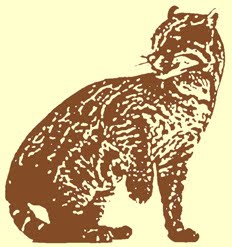
Go here for an introduction to the Screaming Cards.
Traditionally, there are 3 configurations or patterns for the cards, though variants do exist. None of the configurations use the entire pack, and all are arranged as follows:
- The
entire pack is shuffled thoroughly, usually by the person undergoing the
reading ('the Guest').
- The
cards are dealt by the Guest face down onto the table, in the order and
configuration indicated by the person carrying out the reading ('the
Host').
- Cards
should then be turned over, so that they are facing the Guest (though
advanced readings may make use of 'inverted' cards).
Readings for as given Guest may vary over time, due to the
waxing and waning of various factors, both internal and external, such as
emotional states, energy fields and planetary alignments.
The House
A configuration of the
Self
Also known as the Palace or Mountain, this pattern
represents the inner voices and influences of the Guest; their mind,
personality and soul.
The House is made up of three distinct areas: the Door
(outward persona), Windows (inner voices) and Roof (core aspects).
1. The Door
This is how the Guest chooses to
interact with the World. It is their voice, outward demeanour and everyday
persona that they use to present themselves to others.
2. The Southwest Window
This is a minor negative
influence. An inner voice with some malign effect on the Guest's daily
activities.
3. The Southeast Window
This is a minor positive
influence. An inner voice with some benign effect on the Guest's daily
activities.
4. The Northwest Window
This is a major negative
influence. An inner voice with a greater malign effect on the Guest's daily
activities.
5. The Northeast Window
This is a major positive
influence. An inner voice with a greater benign effect on the Guest's daily
activities.
6. The West Roof
This is a deep, unconscious negative
aspect or drive. It is also one of the Guest's spiritual guardians or totems.
7. The East Roof
This is a deep, unconscious
positive aspect or drive. It is also one of the Guest's spiritual guardians or
totems.
8. The Upper Roof (or Chimney)
This is the deepest core aspect
of the Guest's current psyche. It is also the Guest's primary spiritual
guardian or totem.
The Seasons
A configuration of Time
Also known as the Passage or River, this pattern represents
the course of the Guest's life; be it the recent past and immediate future, or
their entire lifespan. It may represent just one aspect of the Guest's life,
such as their career, relationships, finance or health.
The Seasons are divided into rows for Spring (childhood,
birth, renewal, rain), Summer (youth, growth, change, fire), Autumn (adulthood,
maturity, stability, drought) and Winter (old age, decline, closure, ice). Each
Season is made up of the central Earth column (the primary influence) and
bounded by Sun and Moon columns (secondary influences). This of course uses 12
of the 13 cards in the pack. The 13th card is said to be 'outside
time'.
The cards should be dealt as follows:
The Table
A configuration of the
World
Also known as the Hall or Campfire, this pattern represents
the external influences on the Guest. These may be individual people, groups or
organisations. The cards ringing the table represents chairs, each one occupied
by a different being with some effect on the Guest's life, whether that is on a
daily basis, over a long period, or just once.
The Table has an upper female row, a lower male row, plus
one card at the head and one at the foot. The male and female cards are
labelled as such merely for ease of reference and may not actually represent
individual men and women.
The cards should be dealt as follows:
1. The Lord
Someone or something that that
has great power over the Guest. Also known as the Judge.
2. The Lady
Someone or something that that
gives the Guest solace, comfort or sanctuary. Also known as the Abbess.
3. The Brother
Someone or something that that
the Guest trusts and relies on. Also known as the Sergeant.
4. The Lover
Someone or something that that
the Guest desires. Also known as the Mistress.
5. The Rival
Someone or something that that
the Guest is in competition with. Also known as the Opponent.
6. The Maidservant
Someone or something that that
the Guest uses for their own ends. Also known as the Serf.
7. The Enemy
Someone or something that that means
the Guest ill, or works against them. Also known as the Fiend.
8. The Empty Chair
Someone or something that that
the Guest has lost or has been denied. Also known as the Corpse.




1 comment:
We want ladybadger
Post a Comment